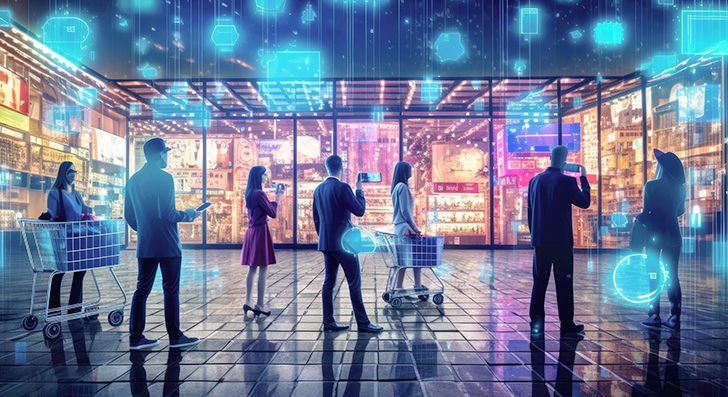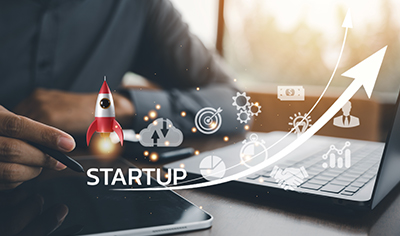The retail industry once characterized by traditional storefronts is undergoing a significant transformation driven by technological advancements to innovate faster and meet the ever-evolving demands of modern consumers. As the industry faces new challenges, staying ahead of the curve is not just a necessity but a strategic advantage for retailers striving to secure their foothold in the competitive landscape, where customer experience reigns supreme.
From small retail stores to multinational conglomerates, businesses are harnessing the latest retail technology trends to quickly adapt to changing consumer behaviors. In fact, a recent survey report reveals that 44% of retailers consider enhancing customer experience as a top priority, followed by improving customer retention at 38% and driving customer acquisition at 32%. Furthermore, Wakefield Research surveyed 100 retail executives from large organizations and found that 94% of them believe that technology plays a critical role in driving new customers. Now, let’s embark on a transformative journey through the technological frontier, uncovering the trends that are reshaping the retail landscape and paving the way for a future where convenience and personalization are at the heart of every shopping experience.
1. Mobile Commerce (m-commerce)
With the widespread adoption of mobile devices and smartphones, mobile commerce (m-commerce) to double its share of retail sales by 2025. Mobile-optimized websites or dedicated mobile applications offer unparalleled convenience, accessibility, and flexibility to customers in their shopping experiences by allowing them to browse, purchase, and interact with retailers from anywhere and at any time. To make a payment, customers can use a credit card, debit card, or buy-now-pay-later service. Furthermore, mobile payment solutions such as digital payment platforms or mobile wallets (Apple Pay) not only streamline the checkout process but also reduce friction, which in turn, enhances the overall shopping experience.
Retailers can also leverage location data to send personalized push notifications to customers on their smartphones. This empowers retailers to target customers with promotions and relevant offers based on their preferences and proximity to stores, leading to increased engagement and sales. What’s more interesting to note is that mobile commerce (m-commerce) facilitates seamless integration between offline and online channels through features like click-and-collect, allowing customers to purchase items online and pick them up in-store, or vice versa. Overall, m-commerce is transforming the retail industry in ways previously unimaginable, enabling retailers to reach a broader audience, drive sales, and foster stronger customer relationships. This could be the reason why the mobile commerce market size is estimated to reach 4.66 trillion by 2032.
2. Data Analytics and Personalization
Data analytics and personalization are reshaping how retailers engage and interact with their customers. By leveraging the limitless potential of data analytics, retailers can gain valuable insights into consumer behavior and preferences. In other words, advanced analytics tools analyze large volumes of data from disparate sources, including demographic information, browsing patterns, and purchase history to uncover hidden patterns and insights. These actionable insights empower retailers to segment their customer base strategically and tailor marketing campaigns to meet the unique needs and preferences of modern consumers.
Besides data analytics, personalization also plays a critical role in revolutionizing the retail industry. Retailers can offer personalized shopping experiences to customers across various touchpoints, including in-store interactions, websites, and mobile applications. What’s more interesting is to note that customers are likely to spend 40% more than planned when the shopping experience is highly personalized. Furthermore, over 60% of consumers stated that they will become repeat buyers with a retailer after a personalized shopping experience. Overall, data analytics and personalization are empowering retailers to better understand their customers’ needs and deliver highly personalized shopping experiences that enhance customer engagement and drive sales in the competitive retail landscape.
How Data Analytics Driving Growth in Retail
3. Robotics and Automation
Robotics and Automation are transforming the retail industry by reducing costs, increasing operational efficiency, and enhancing the overall shopping experience for both retailers and customers. For instance, automated checkout systems, including cashier-less stores or self-checkout kiosks offer frictionless shopping experiences by reducing waiting time and increasing convenience for customers. By 2025, retailers plan to automate nearly 70% of routine store tasks. This could be the reason why the retail automation market size is estimated to reach 37.38 billion USD by 2029.
In warehousing and logistics, robotic solutions automate manual processes such as order picking, packing, and sorting, which in turn improves efficiency, reduces fulfillment times, and drives significant cost savings. Furthermore, robotic systems like AI-powered shelf-scanning robots eliminate the need for manual labor by automating inventory management. Overall, robotics and automation play an integral role in redefining the retail landscape by revolutionizing operations and customer experiences alike.
4. Contactless Payment
With the rise of concerns over hygiene and safety, contactless payment has become increasingly popular in the retail landscape. It allows customers to make secure transactions without physical contact using advanced methods such as QR codes, NFC-enabled cards, and mobile wallets. To make a payment, customers can simply tap their devices to terminals equipped with near-field communication (NFC) technology. This latest technological trend not only offers a more convenient and frictionless checkout experience to customers but also eliminates the risk of spreading bacteria and germs. Today, more than 50% of Americans are using contactless payments, including mobile wallets, like Apple Pay or tap-to-go credit cards. It is estimated that contactless payment transactions globally will surpass 10 trillion USD by 2027.
5. Artificial Intelligence, Machine Learning, and Gen AI
Artificial Intelligence and Machine Learning are no longer buzzwords, in fact, they have been around for several decades and infiltrated across industries, and retail is no exception. These disruptive technologies are transforming various aspects of retail operations. For instance, AI-powered analytics delves into treasure troves of data, including market trends, consumer behavior, and inventory levels, enabling retailers to make data-backed decisions in real-time. Retailers can also leverage Machine Learning algorithms to anticipate customer preferences, optimize pricing strategies, and forecast demand with unprecedented accuracy, leading to reduced costs and improved inventory management.
Generative AI further revolutionizes the retail landscape by enabling retailers to generate novel product concepts and prototypes tailored to individual customer preferences. Furthermore, Gen AI-powered chatbots and virtual assistants provide personalized recommendations to customers, guiding them throughout the shopping journey and offering end-to-end assistance at every touchpoint. Overall, AI, ML, and Generative AI are collectively reshaping the retail industry by empowering retailers to deliver highly personalized and engaging experiences that meet the changing needs and preferences of consumers.
Summing Up
The retail industry is at the cusp of significant transformation fueled by advancements in technological trends. From mobile commerce to AI and Machine Learning, the possibilities for shaping the future of retail are seemingly limitless. These tech trends not only redefine the way consumers shop but also foster greater transparency, efficiency, and agility within the retail ecosystem, enabling retailers to quickly adapt and thrive in the competitive landscape. If you are also planning to capitalize on the potential of these retail technology trends to deliver personalized, frictionless shopping experiences that delight customers and accelerate business growth, you may seek consultation from a reliable partner.






